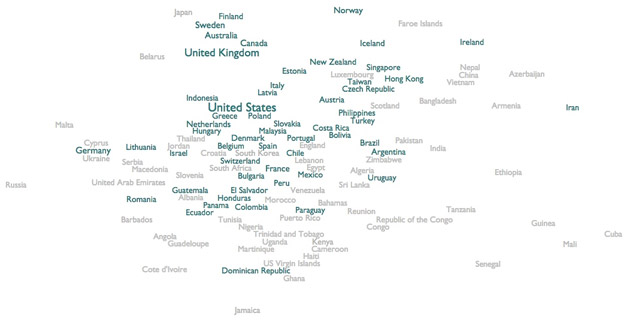
We do, in fact, have per-country top-track charts in Spotify itself. These measure the absolute popularity of tracks among the sub-population listening in a given country. Statistically, though, these charts tend to be fairly well dominated by global hits.
This isn't a technical flaw, but it does mean that those charts are not especially useful for the purpose of musical tourism. When I say I want to hear what they're listening to in Estonia, I mean that I want to hear what they're listening to in Estonia that, proportionally speaking, nobody is listening to anywhere else. I want to hear the music that is most uniquely Estonian, or more precisely the music that is most uniquely loved by Estonians.
So I've been experimenting with code to generate the kind of additional alternate chart that I mean, measuring the most distinctive listening of a country. It's not perfect, and the occasional global hit wanders in due to emotionally irrelevant factors like regional licensing contingencies. But for the most part these charts do appear to be rather effectively getting past the global to the local.
I was going to share an alphabetized list of these, for anybody who shares my curiosity. But I have this code to produce visual maps of music groupings, and it's just as easy to feed it countries as it is to feed it genres. And thus I've done the somewhat bizarre exercise of producing a visual remapping of inherently geographic data using non-geographic coordinates.
This sounds silly, I think. But it turns out to be surprisingly interesting. Here's the map:
This is a readability-adjusted scatter-plot of two acoustic variables averaged across a few thousand of the most popular and representative songs from each country.
The vertical axis is a metric quality we call 'bounciness', so the countries at the top are characterized by denser and more atmospheric music, and the countries at the bottom are characterized by sparer music with spikier beats and more space between them. For example, the constant roar of atmospheric black metal or the slow humming whir of classical organ music would be at the top, and the jumpy beats of hip hop or the pulse of reggae would be at the bottom.
The horizontal axis is another score we call 'organism'. The countries towards the left are characterized by music with more electric arrangements and/or more mechanical rhythms. The extreme of this quality gets you relentless techno. The countries towards the right are characterized by music with more acoustic arrangements and/or more human and variable rhythms. The extremes of this get you jigs and reels, or sitars.
But what's intriguing here, obviously, is not where individual countries appear, but which countries cluster together. Japan, Australia and Canada all basically fall into acoustic Scandinavia. Africa and the Caribbean form a unified acoustic southern hemisphere. Malaysia is acoustically closer to Slovakia than to China, and Lebanon is acoustically closer to South Korea and Mexico than to Iran. I feel like we are detecting at least the faint echoes of a kind of cultural truth.
Click any country to see the calculated playlist of the 100 most distinctively popular songs in that country. You need to have Spotify downloaded for this to work, and as you'll discover, in some cases international publishing rights work counter to personal curiosity, and less than 100 will actually be available for you to stream. If you're extra-curious, in Spotify Preferences you can uncheck 'Hide unplayable tracks', and then you'll at least get to see all 100.
Estonia turns out to be pretty much exactly as awesome as I imagined it had to be if I could only hear it.
This article first appeared on Glenn's furialog personal blog.





